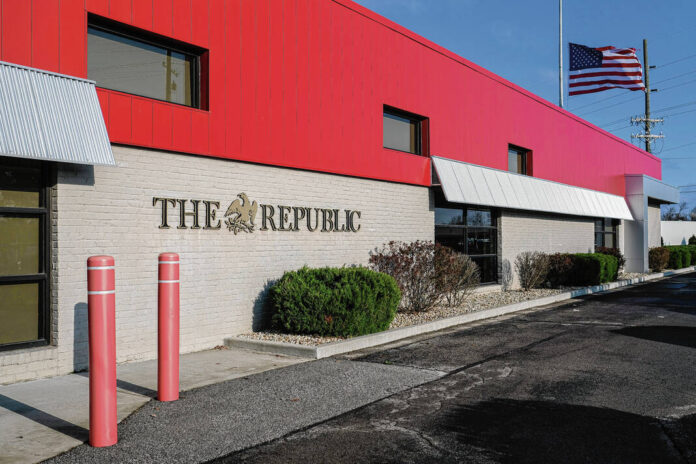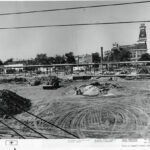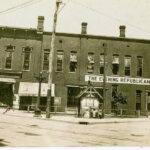
Mike Wolanin | The Republic An exterior of The Republic building on National Road in Columbus, Ind., Friday, April 1, 2022.
The newspaper that readers first picked up from their porch just seven years after the Civil War ended now can be read online from a tablet or phone around the world.
And news that once was updated six days per week in print now can be updated dozens of times per hour online, if need be.
Yet, despite the fast-forward format changes, The Republic is essentially doing the same job it began doing on this date 150 years ago — covering Bartholomew County and the surrounding area’s developments, newsmakers, leaders, visionaries, seeming scoundrels and more.
And in the process, its further aim is allowing readers to share opinions and exchange ideas and perspectives in a diverse public square.
The fledgling enterprise hardly was a sure thing way back in the early days when in a multi-newspaper marketplace. The paper went bankrupt very quickly at one point.
In an altogether different struggle, the newspaper editor and the Columbus mayor got into a street fight in 1877, giving punchy headlines a whole new meaning.
And the paper included heavily partisan material in the early days, including Republican lawmakers’ entire speeches reprinted amid news pages, including the front page.
Columbus resident Jeff Brown, who rose to become president and CEO of Home News Enterprises, The Republic’s former parent company, recently reminisced about the role of his father, Robert N. Brown.
The descendant of original owner and Terre Haute native Isaac T. Brown, a young Bob Brown used to watch, fascinated, as Republic copies were unloaded at its Fifth and Washington streets office. He did this so often that pressmen eventually built him a box to sit upon and watch them work. The elder Brown eventually became an innovator and a visionary for growth in the national newspaper industry soon after he came back to the family business known as The Evening Republican in 1946.
Jeff Brown remembers his father’s overarching impact.
The cutting edge
“He wanted his Evening Republican and then later The Daily Journal in Franklin to be on the cutting edge of production and quality,” Brown said. “So as the new family leader/engineer in the business, the timing could not have been better. It was the golden age of newspapering, and there was a lot to be done in technical transformation. He built two new production plants, with both encompassing innovations in both building design and newspaper processes.
“Design and innovation are what he lived. As a consequence, he rose to prominence in the industry with his technical leadership.”
As Jeff Brown recalls, The Republic became among the first newspapers nationwide to feature its press in a glass windowed-front for the public to clearly see. En route to that symbolic and literal transparency, the elder Brown earned two patents related to the offset production process.
However, in the younger Brown’s prime leadership era, the challenge was different, since the media landscape had dramatically shifted in the early 2000s.
“I was faced with a huge title wave of disruptions to the print industry and the retail business community,” Jeff Brown said. “So we had to be much more nimble and flexible to react to a rapidly changing newspaper environment.
“The family business itself also went from one majority owner to three different cousin family groups and no majority owner. Keeping the business revenue growing by also developing our dominance as a large commercial printer in south/central Indiana helped us continue the business and remain healthy.
“We essentially built and expanded on what previous generations had done. I was also fortunate to inherit a loyal and capable group of employees who were passionate about what they were doing. My greatest satisfaction was seeing our people develop careers and become some of the best of their class in the industry.”
Current Brown County resident Bob Gustin, editor from 1998 to 2011, had been in the top leadership role for only about 90 days when the 100-year flood of June 2008 walloped Columbus, destroying homes, evacuating and damaging Columbus Regional Hospital and upending lives. The paper’s coverage that year won the state Associated Press managing Editor’s top award over papers of all sizes included sportswriters being pulled into breaking news duty, and range flood-related stories for weeks afterward being offered for free online.
Plus, the bottom of the front page for months included news to use for readers restoring valuable keepsakes, working with insurance companies, looking for volunteers to remove waterlogged items and such.
A unifying moment
“During that time, the newspaper almost seemed to be a glue that helped hold the community together,” Gustin said. “I think we gave people a sense of stability.”
Gustin ranks the experience as easily the most significant effort of his 40-plus-year journalism career — and one of the more important ways the paper served a wounded community unifying to recover.
Columbus resident Chuck Wells, who served as Republic publisher then, said he was proud to be part of such a wide-ranging effort to provide residents such practical help and hope.
“We became the ‘go to’ place for news and information on the flood, both in print and online,” Wells said. “We helped this community manage our way through this tragic event … .”
Current Columbus resident John Harmon, the paper’s longest-tenured editor in chief, serving from 1990 to 2008 (and city editor for three years before that), remembers a series of big stories the paper covered in his time: a British firm’s hints of a corporate takeover of then-Cummins Engine Co. in late 1988 (big enough news to make the front page of The New York Times) and Cummins moving its heavy-duty manufacturing line to Jamestown, New York, in 2002, among others. Plus, there was the retirement of longtime Columbus North High School coach and athletic director Bill Stearman in 1998, after nearly half a century in that management role.
But Harmon saw one of the paper’s greatest and perhaps not-so-obvious long-term impacts of his time as highlighting the strength of local schools via news and feature stories. A Monday Classrooms page became a staple for years under his guidance. Plus, just before he was named editor, one of his news reporters earned national honors at one point for education stories.
“We’ve obviously always have been pretty heavy on education coverage,” Harmon said. “Without the newspaper, people without kids in the school corporation might not have been aware of a lot of the fantastic things that teachers, coaches, administrators and others were doing, and those kind of things could just slide by.”
In more recent challenges, today’s Republic staff has covered more than two years of a worldwide pandemic that has affected Columbus’ health, lifestyles, economic stability and nearly every aspect of community life.
The staff has also had a ring-side seat to history as Columbus native Mike Pence was elected vice president of the United States and Columbus had a “center stage” participation in his inauguration.
The Republic received the General Excellence Award in the Hoosier State Press Association’s 2021 Better Newspaper Contest, for overall excellence in all contest categories for all Indiana newspapers of more than 6,000 circulation.
Recording history
Bartholomew County Historian Tamara Iorio understands the impact of The Republic from a long-term view as a researcher, often seeking snapshots of daily life via a daily newspaper.
“Although there are other sources to learn about local history, a daily newspaper gives details about people, places, and events not available anywhere else and so is invaluable,” Iorio said. “Additionally, newspapers cover day-to-day items that may not seem significant at the time but may end up being notable much later.
“Older newspapers give us a window into life in the late 19th and early 20th century with descriptions of visitors coming to town, residents taking trips out of town, prominent citizens falling ill, churches holding picnics, and more.”
Jason Hatton, director of the Bartholomew County Public Library and a board member of the Bartholomew County Historical Society, understands the general power and importance of the printed word perhaps as well as anyone locally. And he has been a staunch defender of free speech via libraries and media.
“I am a huge fan and supporter (of The Republic),” Hatton said. “It is absolutely critical that our community has a local newspaper that reports on what is happening.”
Jeff Brown realizes that his family, and especially his father, always will be in some semblance of the historical spotlight for his near-half-century of service to the community.
“(But) I would be remiss if I didn’t say that no one person, my dad included, was responsible for the success of the business,” Brown said. “It started with two entrepreneurs in 1872, it went bankrupt, it was repurchased by the next generation with the help of Joseph Irwin and went on to win the early community newspaper wars at the turn of the century.
“Each successive generation brought the right leadership to the table matching the challenges of the times.”
Republic file photo
Jeff Brown, then-President of Home News Enterprises LLC, and Jeremy Halbreich, Chairman and CEO at AIM Media Texas LLC, are pictured together Wednesday in the The Republic newsroom in Columbus.
Mike Wolanin | The Republic The Republic Editor Julie McClure and reporter Mark Webber discuss a story he is working on at The Republic in Columbus, Ind., Friday, April 1, 2022.
Mike Wolanin | The Republic The Republic newsroom assistant Megan Stafford works on her computer at The Republic in Columbus, Ind., Friday, April 1, 2022.
Mike Wolanin | The Republic The Republic assistant managing editor Dave Stafford works on the editorial page at The Republic in Columbus, Ind., Friday, April 1, 2022.
Mike Wolanin | The Republic A view of The Republic newsroom in Columbus, Ind., Friday, April 1, 2022.
Mike Wolanin | The Republic The Republic reporter Jana Wiersma works on a story at The Republic in Columbus, Ind., Friday, April 1, 2022.
Mike Wolanin | The Republic The Republic reporter Mark Webber looks over info and discusses a story he is working on at The Republic in Columbus, Ind., Friday, April 1, 2022.
Mike Wolanin | The Republic An exterior of The Republic building on National Road in Columbus, Ind., Friday, April 1, 2022.
Republic file photo A photo of the first edition of The Columbus Republican.
Photo courtesy of Bartholomew County Historical Society A view of The Republic’s press at its home in the modernist building on Second Street.
Clockwise from top left: An exterior view of The Republic at its home in the modernist building on Second Street. // An early 20th century image of the newspaper building at Fifth and Washington Streets in downtown Columbus. // An view of papers being bundled for distribution at The Republic. // An advertisement for the daily and weekly newspapers that were the forerunners of today’s Republic. // Photo of a sign at the entrance to the modernist Second Street building which housed The Republic in downtown Columbus.
Photos courtesy of Bartholomew County Historical Society
Photo courtesy of Bartholomew County Historical Society Construction work begins for The Republic at its home in the modernist building on Second Street.
Photo courtesy of Bartholomew County Historical Society An interior view of The Republic at its home in the modernist building on Second Street.
Photo courtesy of Bartholomew County Historical Society An exterior view of The Republic at its home in the modernist building on Second Street.
Photo courtesy of Bartholomew County Historical Society A view of the publisher’s offices in the Second Street building in downtown Columbus.
Photo courtesy of Bartholomew County Historical Society An view of papers being bundled for distribution at The Republic.
Photo courtesy of Bartholomew County Historical Society An exterior view of The Republic at its home in the modernist building on Second Street.
Photo courtesy of Bartholomew County Historical Society An exterior view of The Republic at its home in the modernist building on Second Street.
Photo courtesy of Bartholomew County Historical Society An exterior view of The Republic at its home in the modernist building on Second Street.
Photo courtesy of Bartholomew County Historical Society An early 20th century image of the newspaper building at Fifth and Washington Streets in downtown Columbus.
Photo courtesy of Bartholomew County Historical Society The nameplate of The Daily Evening Republican.
Photo courtesy of Bartholomew County Historical Society The nameplate of The Columbus Republican.
Photo courtesy of Bartholomew County Historical Society An advertisement for the daily and weekly newspapers that were the forerunners of today’s Republic.
Photo courtesy of Bartholomew County Historical Society In 1872, Isaac T. Brown co-founded a weekly newspaper called the Columbus Republican, forerunner to today’s Republic.
































